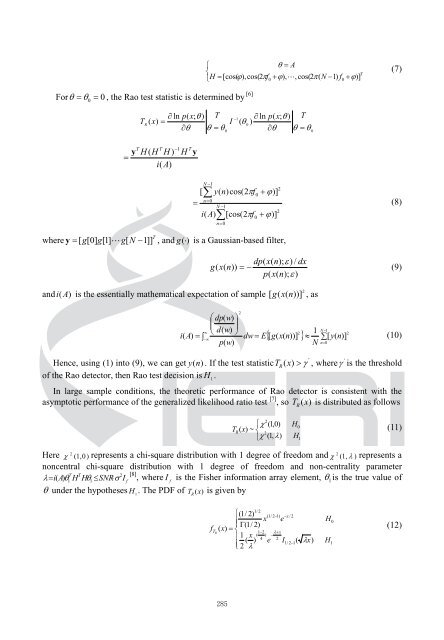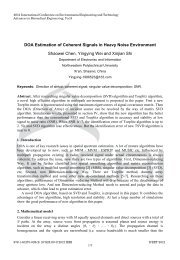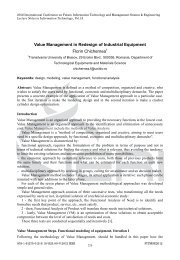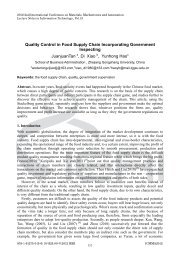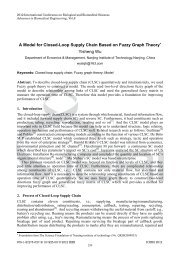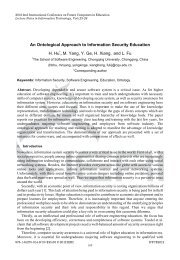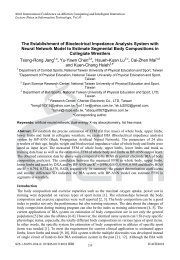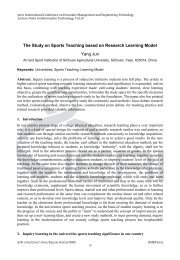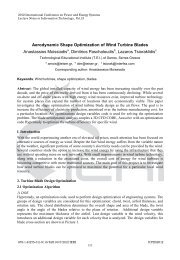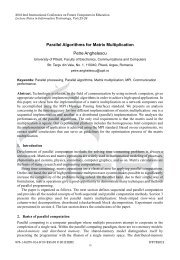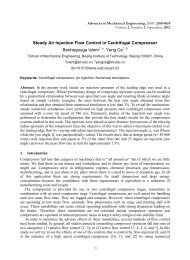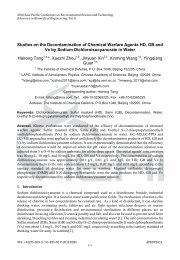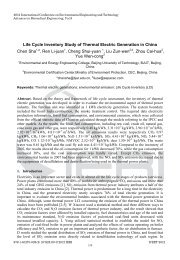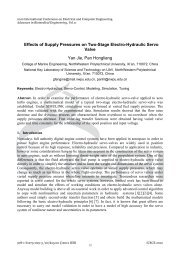A Cooperative Spectrum Detection Technique in Non-Gaussian ...
A Cooperative Spectrum Detection Technique in Non-Gaussian ...
A Cooperative Spectrum Detection Technique in Non-Gaussian ...
You also want an ePaper? Increase the reach of your titles
YUMPU automatically turns print PDFs into web optimized ePapers that Google loves.
⎧<br />
θ = A<br />
⎨<br />
⎩H<br />
= [cos( ϕ),cos(2π<br />
f + ϕ),<br />
,cos(2π<br />
( N −1)<br />
f0<br />
+<br />
T<br />
0<br />
ϕ)]<br />
(7)<br />
For = θ 0<br />
= 0<br />
θ , the Rao test statistic is determ<strong>in</strong>ed by [6]<br />
∂ ln p(<br />
x;<br />
θ ) T<br />
−1<br />
∂ ln p(<br />
x;<br />
θ ) T<br />
( x)<br />
=<br />
I ( θ<br />
0<br />
)<br />
∂θ<br />
θ = θ<br />
0<br />
∂θ<br />
θ = θ<br />
0<br />
T R<br />
1<br />
T T − T<br />
H( H H)<br />
H<br />
= y y iA ( )<br />
∑<br />
[<br />
N −1<br />
∑<br />
n=<br />
0<br />
=<br />
N −1<br />
i(<br />
A)<br />
y(<br />
n)cos(2πf<br />
n=<br />
0<br />
[cos(2πf<br />
0<br />
0<br />
+ ϕ)]<br />
+ ϕ)]<br />
2<br />
2<br />
(8)<br />
where y = [ g[0] g[1] g[ N −1]] T , and g (⋅)<br />
is a <strong>Gaussian</strong>-based filter,<br />
and i (A)<br />
is the essentially mathematical expectation of sample<br />
Hence, us<strong>in</strong>g (1) <strong>in</strong>to (9), we can get y (n)<br />
. If the test statistic<br />
of the Rao detector, then Rao test decision is H<br />
1.<br />
dp(<br />
x(<br />
n);<br />
ε ) / dx<br />
g(<br />
x(<br />
n))<br />
= −<br />
(9)<br />
p(<br />
x(<br />
n);<br />
ε )<br />
2<br />
2<br />
[ g ( x(<br />
n))]<br />
, as<br />
⎛ dp(<br />
w)<br />
⎞<br />
⎜ ⎟<br />
−<br />
∞ ⎝ d(<br />
w)<br />
1<br />
=<br />
⎠<br />
2 1 N<br />
2<br />
i ( A)<br />
∫ dw = E{ [ g(<br />
x(<br />
n))]<br />
} ≈<br />
−∞<br />
∑[<br />
y(<br />
n)]<br />
(10)<br />
p(<br />
w)<br />
N n=<br />
0<br />
T R<br />
'<br />
( x)<br />
> γ , where γ '<br />
is the threshold<br />
In large sample conditions, the theoretic performance of Rao detector is consistent with the<br />
asymptotic performance of the generalized likelihood ratio test [7] , so T R<br />
(x)<br />
is distributed as follows<br />
T R<br />
2<br />
⎧χ<br />
(1,0)<br />
( x)<br />
~ ⎨ 2<br />
⎩ χ (1, λ )<br />
H<br />
0<br />
H<br />
1<br />
(11)<br />
Here χ 2 (1,0 ) represents a chi-square distribution with 1 degree of freedom and χ<br />
2 (1, λ ) represents a<br />
noncentral chi-square distribution with 1 degree of freedom and non-centrality parameter<br />
T T<br />
2<br />
λ=<br />
i( A)<br />
θ1<br />
H Hθ<br />
1<br />
≤SNR⋅<br />
σ I<br />
[8] , where I<br />
f<br />
f<br />
is the Fisher <strong>in</strong>formation array element, θ 1<br />
is the true value of<br />
θ under the hypotheses H . The PDF of<br />
1<br />
T R<br />
(x)<br />
is given by<br />
1/ 2<br />
⎧(1/<br />
2)<br />
⎪ x<br />
f =<br />
Γ(1/<br />
2)<br />
T R<br />
( x)<br />
⎨ 1−2<br />
( )<br />
⎪ 1 x<br />
4<br />
( ) e<br />
⎪⎩<br />
2 λ<br />
e<br />
(1/ 2−1)<br />
−x/ 2<br />
λ+<br />
x<br />
−<br />
2<br />
I<br />
(<br />
1/ 2−1<br />
λx)<br />
H<br />
H<br />
0<br />
1<br />
(12)<br />
285


